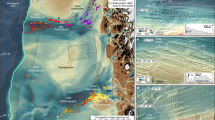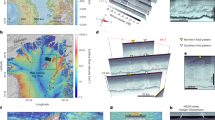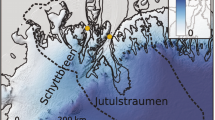Abstract
Fjords commonly punctuate continental edges formerly occupied by Quaternary ice sheets, reaching kilometre depths and extending many tens of kilometres inland1,2. These features must have been created by late Cenozoic ice sheets, because rivers cannot erode bedrock much below sea level. Ice sheets drain primarily through fjords3,4; therefore, widespread fjord insertion may have altered ice-sheet size, shape and dynamics. Here, we use a two-dimensional ice-sheet model to simulate the incision of fjords through a coastal mountain range. We show that topographic steering of ice and erosion proportional to ice discharge are sufficient to form fjords. Within one million years, kilometre-deep fjords punched through the mountain range owing to a robust positive feedback initiated by ice being steered towards mountain passes. Enhanced erosion beneath thicker, faster ice deepens these passes, amplifying the topographic steering. Simulated fjords are deepest through the highest topography and drain a large fraction of the interior ice. Ice sheets simulated on landscapes with existing fjords are generally smaller and exhibit longer response times and larger responses to climate changes, suggesting that modern ice sheets are more sensitive to climate fluctuations than Early Quaternary ice sheets.
This is a preview of subscription content, access via your institution
Access options
Subscribe to this journal
Receive 12 print issues and online access
$259.00 per year
only $21.58 per issue
Buy this article
- Purchase on Springer Link
- Instant access to full article PDF
Prices may be subject to local taxes which are calculated during checkout




Similar content being viewed by others
References
Johnson, D. W. The nature and origin of fjords. Science 41, 537–543 (1915).
Syvitski, J. P. M., Burrell, D. C. & Skei, J. M. Fjords: Processes and Products (Springer, New York, 1987).
Bennett, M. R. Ice streams as the arteries of an ice sheet: Their mechanics, stability and significance. Earth Sci. Rev. 61, 309–339 (2003).
Dowdeswell, J. A., Benham, T. J., Gorman, M. R., Burgess, D. & Sharp, M. J. Form and flow of the Devon Island Ice Cap, Canadian Arctic. J. Geophys. Res. 109, F02002 (2004).
Taylor, J. et al. Topographic controls on post-Oligocene changes in ice-sheet dynamics, Prydz Bay region, East Antarctica. Geology 32, 197–200 (2004).
Stern, T. A., Baxter, A. K. & Barrett, P. J. Isostatic rebound due to glacial erosion within the Transantarctic Mountains. Geology 33, 221–224 (2005).
Shuster, D. L., Ehlers, T. A., Rusmore, M. E. & Farley, K. A. Rapid glacial erosion at 1.8 Ma revealed by 4He/3He thermochronometry. Science 310, 1668–1670 (2005).
Stroeven, A. P., Fabel, D., Harbor, J., Hättestrand, C. & Kleman, J. Quantifying the erosional impact of the Fennoscandian ice sheet in the Tornetrask-Narvik corridor, northern Sweden, based on cosmogenic radionuclide data. Geograf. Ann. A 84A, 275–287 (2002).
Staiger, J. K. W. et al. Quaternary relief generation by polythermal glacier ice. Earth Surf. Process. Landforms 30, 1145–1159 (2005).
Briner, J. P., Miller, G. H., Davis, P. T. & Finkel, R. C. Cosmogenic radionuclides from differentially weathered fiord landscapes support differential erosion by overriding ice sheets. Geol. Soc. Am. Bull. 118, 406–420 (2006).
Nesje, A., Dahl, S. O., Valen, V. & Ovstedal, J. Quaternary erosion in the Sognefjord drainage basin, western Norway. Geomorphology 5, 511–520 (1992).
Dury, G. H. A glacial breach in the northwestern highlands. Scott. Geogr. Mag. 69, 106–117 (1953).
Holtedahl, H. Notes on the formation of fjords and fjord valleys. Geograf. Ann. A 49A, 188–203 (1967).
Sugden, D. E. Glacial erosion by the Laurentide Ice Sheet. J. Glaciol. 83, 367–391 (1978).
Braun, J., Zwartz, D. & Tomkin, J. A new surface-process model combining glacial and fluvial erosion. Ann. Glaciol. 28, 282–290 (1998).
MacGregor, K. C., Anderson, R. S., Anderson, S. P. & Waddington, E. D. Numerical simulations of glacial-valley longitudinal profile evolution. Geology 28, 1031–1034 (2000).
Herman, F. & Braun, J. Evolution of the glacial landscape of the Southern Alps of New Zealand: Insights from a glacial erosion model. J. Geophys. Res. (in the press).
Jamieson, S., Hulton, N. R. J. & Hagdorn, M. Modelling landscape evolution under ice sheets. Geomorphology 97, 91–108 (2008).
Brown, R. Remarks on the formation of fjords and canons. J. R. Geogr. Soc. Lond. 41, 348–360 (1871).
Hallet, B., Hunter, L. & Bogen, J. Rates of erosion and sediment evacuation by glaciers: A review of field data and their implications. Glob. Planet. Change 12, 213–235 (1996).
Paterson, W. S. B. The Physics of Glaciers 3rd edn (Elsevier, New York, 1999).
Kessler, M. A., Anderson, R. S. & Stock, G. S. Modeling topographic and climatic control of east-west asymmetry in Sierra Nevada Glacier length during the Last Glacial Maximum. J. Geophys. Res. 111, F02002 (2006).
Løken, O. H. & Hodgson, D. A. On the submarine geomorphology along the east coast of Baffin Island. Can. J. Earth Sci. 8, 185–195 (1971).
Hughes, T. Calving bays. Quat. Sci. Rev. 21, 267–282 (2002).
Meier, M. F. & Post, A. Fast tidewater glaciers. J. Geophys. Res. 92, 9051–9058 (1987).
Pfeffer, W. T. A simple mechanism for irreversible tidewater glacier retreat. J. Geophys. Res. 10.1029/2006JF000590 (2007).
Broecker, W. S. Massive iceberg discharges as triggers for global climate change. Nature 372, 421–424 (1994).
Oerlemans, J. An attempt to simulate historic front variations of Nigardsbreen, Norway. Theor. Appl. Climatol. 37, 126–135 (1986).
Pfeffer, W. T. et al. Numerical modeling of late Glacial Laurentide advance of ice across Hudson Strait: Insights into terrestrial and marine geology, mass balance, and calving flux. Paleoceanography 12, 97–110 (1997).
Gjessing, J. Om iserosjon, fjorddal- og dalendedannelse; on ice erosion, fiord-valley and valley-end formation. Norsk Geografisk Tidsskrift 15, 243–269 (1956).
Acknowledgements
This research was partially financially supported by NSF (EAR-0644966; EAR 0549566). Support for M.A.K. came from CU postdoctoral research funds and N. Kessler. We appreciate careful reading of an early manuscript by Y. Axford, M. M. Berlin, D. Hess, M. Duhnforth, D. Ward, B. Hallet and T. Stern.
Author information
Authors and Affiliations
Corresponding author
Rights and permissions
About this article
Cite this article
Kessler, M., Anderson, R. & Briner, J. Fjord insertion into continental margins driven by topographic steering of ice. Nature Geosci 1, 365–369 (2008). https://doi.org/10.1038/ngeo201
Received:
Accepted:
Published:
Issue Date:
DOI: https://doi.org/10.1038/ngeo201
This article is cited by
-
An ancient river landscape preserved beneath the East Antarctic Ice Sheet
Nature Communications (2023)
-
The extreme yet transient nature of glacial erosion
Nature Communications (2022)
-
The impact of glaciers on mountain erosion
Nature Reviews Earth & Environment (2021)
-
The empirical basis for modelling glacial erosion rates
Nature Communications (2020)
-
Internal layering structure and subglacial conditions along a traverse line from Zhongshan Station to Dome A, East Antarctica, revealed by ground-based radar sounding
Applied Geophysics (2020)



